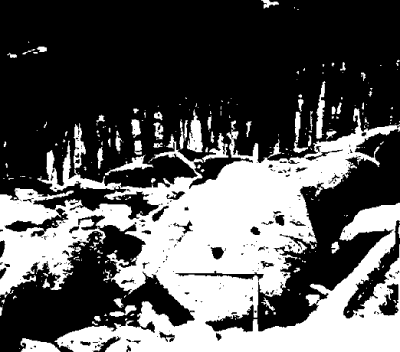 |
Science Frontiers ONLINE No. 113: Sep-Oct 1997 |
|
|
Triangular Holes In Boulders
Recently, someone who wishes to remain anonymous, inspired after reading our Ancient Man, wrote us about a curious discovery of his. He had found some triangular holes in a granite boulder near Raleigh, NC. We have mentioned similar triangular holes before (SF#69/ 20), noting that hundreds of such holes had been recorded in boulders from Minnesota and the Dakotas to the eastern seaboard. We can now add to this dossier a photograph supplemented by this individual's testimony.
"Soon after Hurricane Fran struck Raleigh in September 1996, I was walking one of my customary routes along a local creek when my attention was arrested by a �-ton granite boulder in the creek bed. The boulder had 3 holes drilled in its face, about 6 inches apart, and all in a straight line. (See photo.) I had not noticed this boulder before, so I'm fairly confident it was uncovered by the storm's 10-inch deluge of rain. Because the three holes seemed too close together to be blasting holes, I took a closer look at them and was surprised to see that they had "trianguloid" cross sections rather than round ones. By "trianguloid" I mean the cross section was thus:
Casts of the holes were made by using modeling clay. The expanded bases of the casts suggest that a shallow pit was pecked out of the granite before drilling began, and the constricted tips show that the first 3/4 inch of the drill bit was of a smaller diameter, perhaps to give it greater penetrating power so that the holes could be started more easily. The smaller "pilot" holes were also trianguloid in cross section."
(Anonymous; personal communication, May 27, 1997.)
Comment. In SF#69, it was proposed that the triangular holes were made in that shape so that wooden shafts, also of triangular cross section, could be inserted, given a quarter turn, thereby wedging the shaft firmly in place. This idea is behind the speculation that these strange boulders are really ancient "mooring stones." In truth no one really knows how old they are and what their purpose was. The final explanation may be mundane and/or trivial.
Reference. The Handbook Ancient Man, mentioned above, presents a wide spectrum of archeological anomalies. For a description, visit here.
 | "Trianguloid" holes drilled in a granite boulder as photographed from 10 feet. Scale length: 13 inches. |